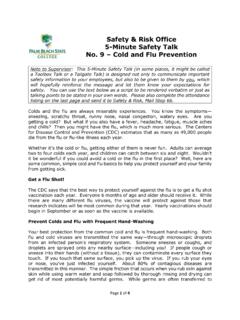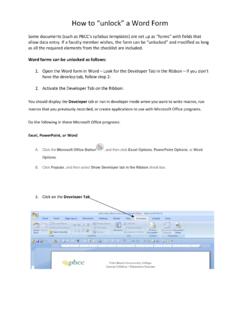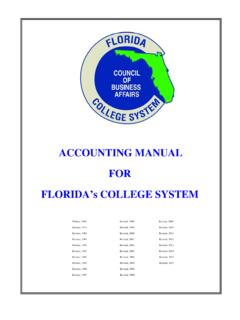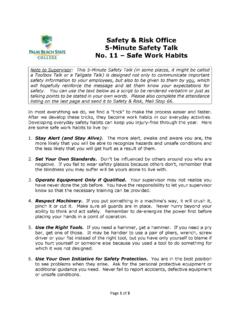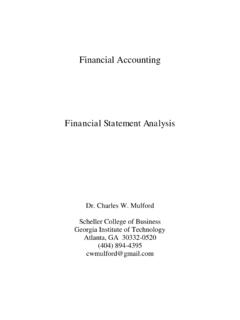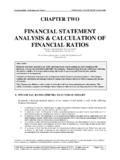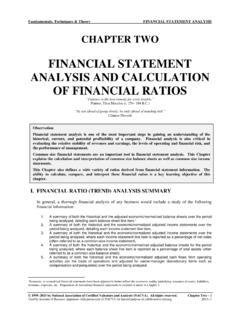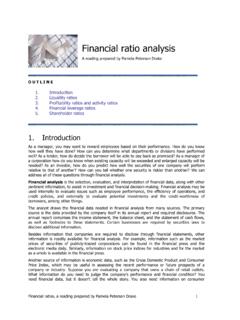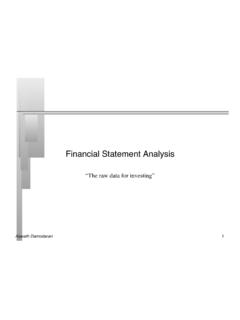Transcription of Financial Statement Analysis - Palm Beach State …
1 The McGraw-Hill Companies, Inc., 2015. All rights reserved. Solutions Manual, Chapter 15 1 Chapter 15 Financial Statement Analysis Solutions to Questions15-1 Horizontal Analysis examines how a particular item on a Financial Statement such as sales or cost of goods sold behaves over time. Vertical Analysis involves Analysis of items on an income Statement or balance sheet for a single period. In vertical Analysis of the income Statement , all items are typically stated as a percentage of sales. In vertical Analysis of the balance sheet, all items are typically stated as a percentage of total assets. 15-2 By looking at trends, an analyst hopes to get some idea of whether a situation is improving, remaining the same, or deteriorating.
2 Such analyses can provide insight into what is likely to happen in the future. Rather than looking at trends, an analyst may compare one company to another or to industry averages using common-size Financial statements. 15-3 Price-earnings ratios reflect investors expectations concerning future earnings. The higher the price-earnings ratio, the greater the growth in earnings investors expect. For this reason, two companies might have the same current earnings and yet have quite different price-earnings ratios. By definition, a stock with current earnings of $4 and a price-earnings ratio of 20 would be selling for $80 per share. 15-4 A rapidly growing tech company would probably have many opportunities to make investments at a rate of return higher than stockholders could earn in other investments.
3 It would be better for the company to invest in such opportunities than to pay out dividends and thus one would expect the company to have a low dividend payout ratio. 15-5 The dividend yield is the dividend per share divided by the market price per share. The other source of return on an investment in stock is increases in market value. 15-6 Financial leverage results from borrowing funds at an interest rate that differs from the rate of return on assets acquired using those funds. If the rate of return on the assets is higher than the interest rate at which the funds were borrowed, Financial leverage is positive and stockholders gain. If the return on the assets is lower than the interest rate, Financial leverage is negative and the stockholders lose.
4 15-7 If the company experiences big variations in net cash flows from operations, stockholders might be pleased that the company has no debt. In hard times, interest payments might be very difficult to meet. On the other hand, if investments within the company can earn a rate of return that exceeds the interest rate on debt, stockholders would get the benefits of positive leverage if the company took on debt. 15-8 The market value of a share of common stock often exceeds the book value per share. Book value represents the cumulative effects on the balance sheet of past activities, evaluated using historical prices. The market value of the stock reflects investors expectations about the company s future earnings.
5 For most companies, market value exceeds book value because investors anticipate future earnings growth. 15-9 A 2 to 1 current ratio might not be adequate for several reasons. First, the composition of the current assets may be heavily weighted toward slow-turning and difficult-to-liquidate inventory, or the inventory may contain large amounts of obsolete goods. Second, the receivables may be low quality, including large amounts of accounts that may be difficult to collect. The McGraw-Hill Companies, Inc., 2015. All rights reserved. 2 Managerial Accounting, 15th Edition The Foundational 15 1. The earnings per share is computed as follows: Net incomeEarnings per share = Average number of common shares outstanding$92,400= = $ per share120,000 shares 2.
6 The price-earnings ratio is computed as follows: Market price per sharePrice-earnings ratio = Earnings per share$ = (rounded)$ 3. The dividend payout ratio is computed as follows: Dividends per shareDividend payout ratio = Earnings per share$ = 71% (rounded)$ The dividend yield ratio is computed as follows: Dividends per shareDividend yield ratio = Market price per share$ = 20%$ The McGraw-Hill Companies, Inc., 2015. All rights reserved. Solutions Manual, Chapter 15 3 The Foundational 15 (continued) 4. The return on total assets is computed as follows: Net income +[Interest expense (1 - Tax rate)]Return on total assets = Average total assets $92,400 + [$8,000 (1 - )]= = $450,000 + $460,000 /2 5.
7 The return on equity is computed as follows: Net incomeReturn on = equityAverage stockholders' equity$92,400= = 28%($320,000 + $340,000)/2 6. The book value per share is computed as follows: Total stockholders' equityBook value per share = Number of common shares outstanding$320,000= = $ per share (rounded) 120,000 shares 7. The working capital and current ratio are computed as follows: Working capital = Current assets - Current liabilities= $150,000 - $60,000 = $90,000 Current assetsCurrent ratio = Current liabilities$150,000= = $60,000 The McGraw-Hill Companies, Inc., 2015. All rights reserved. 4 Managerial Accounting, 15th Edition The Foundational 15 (continued) 8.
8 The acid-test ratio is computed as follows: Cash + Marketable securities + Accounts receivable + Short-term notesAcid-test ratio = Current liabilities$35,000 + $0 + $60,000 + $0= = (rounded) $60,000 9. The accounts receivable turnover is calculated as follows: Sales on accountAccounts receivable = turnoverAverage accounts receivable balance$700,000= = (rounded)($60,000 + $50,000)/2 The average collection period is computed as follows: 365 daysAverage collection period = Accounts receivable turnover365 days= = days (rounded) 10. The inventory turnover is computed as follows: Cost of goods soldInventory turnover = Average inventory balance$400,000= = (rounded)($55,000 + $60,000)/2 The average sale period is computed as follows: 365 daysAverage sale period = Inventory turnover365 days= = days (rounded) The McGraw-Hill Companies, Inc.
9 , 2015. All rights reserved. Solutions Manual, Chapter 15 5 The Foundational 15 (continued) 11. The operating cycle is computed as follows: Operating cycle = Average sale period + Average collection period= days + days = days 12. The total asset turnover is computed as follows: SalesTotal asset turnover = Average total assets$700,000= = (rounded)($450,000 + $460,000)/2 13. The times interest earned ratio is computed as follows: Earnings before interest expense and income taxesTimes interest = earned ratioInterest expense$140,000= = $8,000 14. The debt-to-equity ratio is computed as follows: Total liabilitiesDebt-to-equity ratio = Stockholders' equity$130,000= = (rounded)$320,000 15.
10 The equity multiplier is computed as follows: Average total assetsEquity multiplier = Average stockholders' equity($450,000 + $460,000)/2= = (rounded)($320,000 + $340,000)/2 The McGraw-Hill Companies, Inc., 2015. All rights reserved. 6 Managerial Accounting, 15th Edition Exercise 15-1 (15 minutes) 1. This Year Last Year % % Cost of goods sold .. Gross margin .. Selling and administrative expenses: Selling expenses .. Administrative expenses .. Total selling and administrative expenses Net operating income .. Interest expense .. Net income before taxes .. % % 2.



